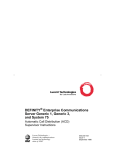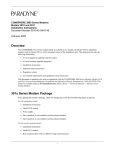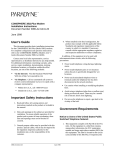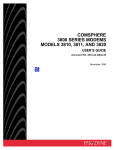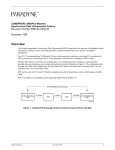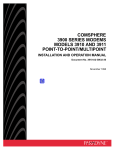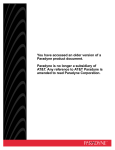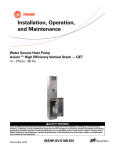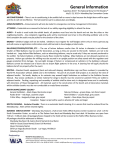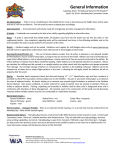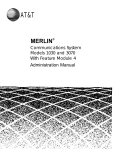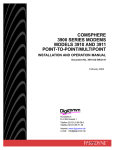Download Lucent Technologies 6 Stereo Receiver User Manual
Transcript
Conference Reservation and Control System (CRCS) Release 6.0 Installation 555-027-109 Comcode 108382085 Issue 1 April 1999 Copyright© 1999 Lucent Technologies Inc. All Rights Reserved Printed in U.S.A. Users outside of the US and Canada should contact their local authorized Lucent Technologies distributor if they want to order additional copies of this document. Also, users in these countries should send any comments on the document to their local authorized Lucent Technologies distributor. Notice Lucent Technologies Inc. Fraud Intervention While reasonable effort was made to ensure that the information in this document was complete and accurate at the time of printing, Lucent Technologies Inc. and its authorized agents cannot assume responsibility for errors. Changes and/or corrections to the information contained in this document may be incorporated in future issues. Names and addresses used for examples throughout this guide are fictitious. If you suspect you are being victimized by toll fraud and you need technical support or assistance, call the BCS Technical Service Center Toll Fraud Intervention hotline at 800 643-2353. Comments To comment on this document, complete and fax in the comment card at the end of the document. Your Responsibility for Your System’s Security Technical Support You are responsible for the security of your system. Lucent Technologies Inc. does not warrant that this product is immune from or will prevent unauthorized use of common-carrier telecommunications services or facilities accessed through or connected to it. Lucent Technologies Inc. will be not responsible for any charges that result from such unauthorized use. Product administration to prevent unauthorized use is your responsibility and your system administrator should read all documents provided with this product to fully understand the features available that may reduce your risk of incurring charges. Call: Trademarks and Copyright Acknowledgments Concorde is a trademark of PictureTel Corp. DEFINITY is a registered trademark of Lucent Technologies Inc. in the United States and throughout the world Lotus 1-2-3 is a registered trademark of IBM Microsoft Windows 95 and Windows NT are registered trademarks of Microsoft Corporation SatisFAXtion is a registered trademark of PureData Sportster is a registered trademark of U.S. Robotics WinFax is a registered trademark of Delrina Technology Inc. Zetafax is a registered trademark of Equisys Limited Screen shots of Microsoft Windows 95/NT 4.0 reprinted with written permission from Microsoft Corporation. Ordering Information Call: Lucent Technologies BCS Publications Center Voice: 800 457-1235 International Voice: 317 322-6416 Fax: 800 457-1764 International Fax: 317 322-6699 Write: Lucent Technologies BCS Publications Center 2855 N. Franklin Road Indianapolis, IN 46219 Order: Document No. 555-027-109 Comcode No.108392085 Issue 1, April 1999 You can be placed on a standing order list for this and other related documents you may need. Standing order will enable you to automatically receive updated versions of individual documents or document sets, billed to account information that you provide. For more information on standing orders, or to be put on a list to receive future issues of this document, contact the Lucent Technologies BCS Publications Center. Video Technical Center (VTC) 800 242-2121 then follow the prompts for video conferencing International Technical Assistance Center (ITAC) 303 804-3777 Contents n Installation Overview n Upgrading from a Previous Release 2 Upgrading a Single-User System 2 1 n Pre-Installation Requirements 5 CRCS/OpCenter and OpCenterSP Checklist 5 Fax Option 6 n Configuring the PC n Connecting the PC to the MCU 7 9 Local Connection to MCU 9 Remote Connection to MCU 10 Connection Procedure 10 Checking the Modem Settings 12 n CRCS/OpCenter Software Installation n Testing CRCS 15 19 Logging In to CRCS 19 Setting the Time Zone 20 Adding the MCU 21 Establishing the Communications Link 22 Uploading MCU Options 24 Running the MCU Extension Utility Program 24 Adding an Endpoint 24 Adding a Conference Template 26 Adding a Company 27 Adding a Person 27 Adding a Site 28 Editing Defaults 30 Adding a Test Conference 30 n Testing OpCenter n Faxmodem Installation 31 Windows 95 32 Windows NT 4.0 32 Installing WinFax PRO 8.0 33 Saving Faxes with WinFax Log Files 37 Setting Up Reminder Faxes 37 32 Issue 1 CRCS R6.0 April 1999 iii Contents n OpCenterSP Installation n Testing OpCenterSP n Appendix A: Modem Pooling 42 44 Administering Modem Pool Groups 44 3800 Series Modem Installation 48 3810 48 3820 53 3830 53 7400A Data Module Installation iv 38 Issue 1 CRCS R6.0 April 1999 54 Single-User CRCS/OpCenter and OpCenterSP Installation Installation Overview CRCS/OpCenter and OpCenterSP can be set up as a single-user system on a dedicated PC connected to up to 2 Lucent Technologies MultiPoint Conferencing Units (MCU). The CRCS/OpCenter PC can run either Microsoft® Windows NT 4.0 or Microsoft Windows 95. The connection between the CRCS/OpCenter or the OpCenterSP PC and the MCU can be local if the distance between the two is less than 5000 feet. The connection is considered remote if the distance is greater than 5000 feet. Also, if the CRCS/OpCenter or OpCenterSP PC is not connected to the TN754B or TN2224 on the MCU side, the connection is considered remote. Follow the installation procedures outlined in this guide to set up and connect the CRCS/OpCenter or the OpCenterSP PC to the MCU. This manual also includes installation procedures for the fax option available with CRCS. Issue 1 CRCS R6.0 April 1999 1 Upgrading from a Previous Release Upgrading from a Previous Release Each new release of the CRCS/OpCenter program and the MCU offers additional features. If any endpoint already included in your previous release supports some or all of the new enhancements, you may need to update the bandwidth, protocols, and feature entries in the Conference Template, Endpoint, Site, and MCU databases. Beginning with release 6.0, CRCS is backward compatible with the previous release MCU. The two MCUs controlled by CRCS do not need to be the same release. For example, MCU1 could be release 6.0 and MCU2 could be release 5.0.47. NOTE: If upgrading from a release earlier than CRCS 4.2, remove all reservation system items including link manager and command manager from the StartUp group prior to installation. Upgrading a Single-User System The first consideration before upgrading from an earlier release is to make sure your hardware and operating system meets the higher minimum requirements of the release of CRCS/OpCenter. See "Pre-Installation Requirements" for a list of the required hardware components, software, and operating system. Also make sure you have the list of logins and passwords as defined. With the proper hardware installed, use the following upgrade procedure to load the new release of CRCS: 1. Before upgrading, you need to run the database repair program. To do so, click Start—Programs—Lucent Technologies CRCS—Run Database Repair. If there are any errors reported, click Start—Programs—Accessories—System Tools—Scan Disk. 2. Backup the database to external media such as floppy disk, zip disk, or tape. This database file named crs.mdb is located in the dbase subdirectory (where CRCS was previously installed). You can perform a Start— Find to locate the file or look in your CRCS directory under the dbase folder. It may be located on your main boot drive. NOTE: If you changed the name of the default directory or destination drive when you previously installed CRCS, copy the crs.mdb file to the dbase subdirectory of the new directory before installing CRCS and readministering the link. For example, if you name the directory c:\crcs6x, you would need to 2 Issue 1 CRCS R6.0 April 1999 Upgrading a Single-User System create a subdirectory named c:\crcs6x\dbase and copy the crs.mdb file into it before installing CRCS. 3. From the MCU MT, perform an add login and change permissions to create the crcs login, password, and permissions (see MCU Administration for details). 4. Insert the CRCS CD-ROM and click Start on the Windows Taskbar. NOTE: Make sure no other applications are running, including fax programs. 5. Click Run and use the Browse button to locate the setup.exe file on the CD-ROM. Click OK. 6. Follow the program prompts (see "CRCS/OpCenter Software Installation" on page 15 for details) and when the installation is complete, choose to exit without the automatic reboot (the No option) and shutdown your PC. 7. Power off your PC. 8. Wait a few seconds and power on the PC. 9. Login to CRCS as an administrator. 10. From the Admin menu on the Main window, select Query MCU Parameters for each MCU (1 and/or 2). 11. Schedule a test conference to begin immediately, verify that the conference downloads to the MCU and record the CRCS ID #. 12. From the MCU MT, perform a list conference to verify the conference downloaded to the MCU. If the connection is established, the upgrade is complete. For remote connections only, continue to step 13. 13. For remote connections, you can administer when the link between CRCS and the MCU is connected. It can be connected full time (permanent), only when a conference data is being downloaded (on-demand), or during a specified hours in a day (between). From the CRCS PC, administer a connect time from the Admin menu on the Main window, select Run Link Admin. 14. From the MCU Link Administration window, click the Connect Parameters tab. n for the on-demand option, specify the time (in minutes) that the link should remain connected. n for the between option, specify the time range when the link will be connected. Also, for off-hours (those hours that fall outside the time range) specify the time (in minutes) that the link should remain connected when requested. Issue 1 CRCS R6.0 April 1999 3 Upgrading from a Previous Release Figure 1. MCU Link Administration window 15. The upgrade process is complete and you can begin using CRCS/ OpCenter. 4 Issue 1 CRCS R6.0 April 1999 CRCS/OpCenter and OpCenterSP Checklist Pre-Installation Requirements As a single-user dedicated system on a PC connected to one or two Lucent Technologies MultiPoint Conferencing Units (MCU), CRCS/OpCenter or OpCenterSP can be set up as either local or remote. For a local connection, the distance between the PC and MCU must be less than 5000 feet. Distances beyond 5000 feet are considered remote. Also, if the PC is not connected to the TN754B or TN2223 on the MCU side, the connection is remote. CRCS/OpCenter and OpCenterSP Checklist Hardware Requirements The system installed for single-user CRCS/OpCenter must be dedicated for CRCS/OpCenter use only. The following hardware components are required: n 266 MHz Pentium II CPU with 64 MB RAM or greater recommended (minimum 100 MHz Pentium with 32 MB RAM) n 1024 by 768 pixel resolution, 256 color, and small fonts n One 17-inch monitor (minimum 15 inch) n 2.5 GB hard disk with a high-speed drive and local bus controller (minimum 1.2 GB) n One 1.44 MB 3.5 inch floppy disk drive n One 6X CD-ROM drive (minimum 4X) n A COM1 serial port with a 25-pin connector or a 9-to-25 pin adapter, if the COM1 port is 9 pin n A bus mouse or a serial mouse connected to a COM serial port n Optional laser or laser-quality printer connected to the LPT1 parallel port and installed as the default printer n Optional (highly recommended) backup tape or high capacity removable disk device and appropriate software for the backup n Slot for the fax hardware (optional) Software Requirements n Microsoft Windows 95 or Windows NT 4.0 workstation with Service Pack 4 Issue 1 CRCS R6.0 April 1999 5 Pre-Installation Requirements Remote Configurations For remote configurations where the MCU and CRCS/OpCenter or OpCenter SP are not collocated, modem pooling is used (see "Appendix A: Modem Pooling" on page 44). The modems must support a minimum of 9600 baud. Additional serial ports may be required which must support non-shared interrupts. Login and Passwords Be sure you know the following information: n Login, password, dialed number and COM port for each MCU n CRCS or OpCenterSP Serial Number n Default administrator password and agent password n PC login and password, if applicable Fax Option Refer to "Faxmodem Installation" on page 32 for hardware and software requirements for the optional fax feature. 6 Issue 1 CRCS R6.0 April 1999 Fax Option Configuring the PC Regardless of whether the connection between the PC and the MCU is local or remote, you must supply the proper adapter to connect the COM1 port to the RS232 cable. Configure your CRCS/OpCenter or OpCenterSP PC as follows: Figure 2. Microsoft Windows Control Panel Settings 1. With your PC powered on, select Start—Settings—Control Panel. 2. Perform each of the following steps: n select the Regional Setting and Keyboard to set both to English (United States) n set the Display by selecting Settings to 1024 by 768 pixels, 256 color, and small fonts Issue 1 CRCS R6.0 April 1999 7 Configuring the PC . Figure 3. Display Properties Window n select Modem and use the Modem Installation wizard to set the modem COM ports. Click Add then Don’t detect my modem. Under Manufacturers, choose Standard Modem Types. Under Models, select Standard 9600 bps Modem. Choose the appropriate COM port: Communications Port (COM 1) for the MCU 1 connection and COM2 for the MCU 2 connection. Figure 4. Install New Modem Wizard—Selecting the COM Port 8 Issue 1 CRCS R6.0 April 1999 Local Connection to MCU Connecting the PC to the MCU This procedure establishes the connection between the CRCS/OpCenter PC and the data module or modem. For information about connecting the data module or modem to the MCU, see the MCU Installation and Test manual. To connect the PC using the standard serial ports to the modem or data module, follow these steps: Local Connection to MCU The following hardware is required for a local MCU connection: n 8400B data module (supplied) NOTE: 7400B data module is supported from previous releases n M25B cable (not supplied) n 9-pin-to-25 pin RS232 adapter (not supplied) MCU COM 1 RS232 Cable 8400B/7400B PBX Wall Jack PC To MCU Port 1 Phone Line D8W Cord Figure 5. Local Connection to the MCU Issue 1 CRCS R6.0 April 1999 9 Connecting the PC to the MCU Remote Connection to MCU When the PC is located remotely from the MCU, the MCU’s modem pooling capability is ideal for connecting the data link needed to support CRCS/OpCenter. With modem pooling, Hayes-compatible analog modems are used at the PC to connect over the PTSN to the MCU. The MCU implements an external 7400A data module combined with a 3800 modem running 9600 bps to provide conversion resources needed to route the analog voice calls from the CRCS to the digital Netcon channels in the MCU. There are two types of conversion resources for modem pooling. The first type, an integrated conversion resource, is a circuit pack which emulates a Trunk Data Module connected to a 212A-type modem. The MCU does not support the integrated modem solution. The second type, a combined conversion resource, is a separate Trunk Data Module and modem administered as a unit. The Trunk Data Module component of the conversion resource may be either a Modular Trunk Data Module (MTDM) or a 7400A data module. The module connects to a digital port using Digital Communications Protocol (DCP); the 3800 modem connects to an analog port on the TN746B. The MCU supports the Combined Modem Pooling Solution for use in remote connectivity between the MCU and the CRCS module whenever these components are not collocated. See "Appendix A: Modem Pooling" for further installation details. Connection Procedure 1. Connect the COM1 port to the 8400B/7400B data module with an appropriate adapter, if necessary, and an M25B (EIA-232-D) cord or equivalent. If using modem pooling, use an analog modem instead. 2. Use an RS232 cable (M25B) with a 25-pin female connector for the CRCS PC or server and a 25-pin male connector for the analog modem (remote connection) or data module (local connection). 3. If your supplied cable does not have the appropriate gender connectors, use a gender changer to make the adjustments. 4. PC ports are usually labeled with the port number and type (serial or parallel), if not see your PC user manual for proper labeling. If the first serial port is a 9-pin connector, connect a 9-pin-to-25-pin RS232 adapter (you supply). 10 Issue 1 CRCS R6.0 April 1999 Connection Procedure TDM Bus TN746B DS1 TN754B Analog 3800 Analog 3800 DCP 7400A DCP 7400A RS232 Voice Grade Data Call Public/Private Network Analog Modem RS232 PC Figure 6. Remote CRCS Connection to MCU (Modem Pooling) 5. Connect the female end of the RS232 cable to the male end of either an adapter or the CRCS PC first serial port. 6. Connect the male end of the RS232 cable to the female 25-pin RS232 connector on the analog modem (remote connection) or data module (local connection). 5000 Feet MCU TN754B/ TN2224 B25A Cross-Connect at MDF 103A or Wall Jack D8W M25B 7400B/8400B PC Figure 7. Connecting the MCU to the CRCS PC 7. If you are using the 8400B data module (TN2224 required), go to step 8. If you are using the 7400B data module, verify or change the following dip switch settings: n For a standalone data-only 7400B data module, set dip switch #1 to ON (UP), if no phone is connected. All other dip switches should be set to the OFF position (DOWN); n If you are using a phone on a 7400B data module, set all dip switches to the OFF position (DOWN). 8. Continue with "Checking the Modem Settings" on page 12. Issue 1 CRCS R6.0 April 1999 11 Connecting the PC to the MCU Checking the Modem Settings The last step before loading the CRCS program requires that you configure and check the modem connection to the MCU. 1. From Microsoft Windows, select Start—Programs—Accessories— HyperTerminal. 2. From the HyperTerminal window, click the Hypertrm.exe icon. Figure 8. HyperTerminal Window Setting 3. Enter Test in the Name field of the Connection Description window and select the first icon as shown. Click the OK button. 4. Click on Connect Using and select Direct to COM1. 12 Issue 1 CRCS R6.0 April 1999 Checking the Modem Settings 5. Choose the following settings: n Connector=Com1 n Baud Rate=9600 n Data Bits=8 n Stop Bits=1 n Parity=None n Flow Control=None 6. Click the OK button to save the changes. If you are using the 8400B data module, continue to step 7. For the 7400B data module, skip to step 10. 7. Type ats24=001 to set the data module for standalone operation without a telephone. 8. Remove power from the 8400B data module for 5 seconds. 9. Reconnect power to the 8400B data module. The red LED comes on steady. 10. Type at and press Enter. The OK prompt appears. Type atdt and the dial number you recorded earlier. Press Enter. The login prompt appears. Figure 9. Connection Description Window Issue 1 CRCS R6.0 April 1999 13 Connecting the PC to the MCU 11. When the login for the MCU displays, enter the login and password assigned by the technical center during installation to verify that you have a working CRCS to MCU link. 12. Type logoff and exit hyperterminal. Repeat this procedure to test COM2 if you are controlling a second MCU. NOTE: If the MCU login does not display, verify that the MCU recognizes that CRCS is active (from the MT check the Scheduler Adjunct field on the customer-options form. It must be set to y). 13. Continue to "CRCS/OpCenter Software Installation" on page 15 to load the CRCS/OpCenter program. 14 Issue 1 CRCS R6.0 April 1999 Checking the Modem Settings CRCS/OpCenter Software Installation NOTE: If your system encounters a conflict with another application while running setup, make sure all other Windows applications are closed before proceeding. 1. Complete the PC connections by connecting the power cord and plug, inserting the mouse cord in an available COM port or installing the bus mouse, and turning on the power. Figure 10. Loading the CRCS/OpCenter Software 2. Insert the CRCS CD-ROM. 3. From the Windows desktop, click Start—Run.... 4. From the Run window, click the Browse button to locate the CRCS CDROM setup program or type the letter assigned to the CD-ROM driver followed by a colon (:), a backslash (\), and the word setup.exe. For example: g:\setup.exe would be the entry if the CRCS CD-ROM was inserted in drive g. Click OK. Figure 11. CRCS Setup—Entering the Location of the CRCS CD-ROM Issue 1 CRCS R6.0 April 1999 15 CRCS/OpCenter Software Installation 5. When the CRCS/OpCenter setup wizard window appears, click Next. 6. When the product identification window appears, enter your name, company, and CRCS serial number. Click Next. 7. From the Select Components window, select to install Conference Scheduler and the ODBC drivers. Click Next. Figure 12. CRCS Setup—Select Components 16 Issue 1 CRCS R6.0 April 1999 Checking the Modem Settings 8. From the Choose Destination Location window, CRCS offers install to a path called c:\program files\lucent\crcs. If there is no directory by that name, the setup wizard will create one for you. You can also change the destination drive by replacing c: with the appropriate drive letter. Click Next. Figure 13. CRCS Setup—Destination Location 9. From the Start Copying Files window, the setup wizard displays the selected components to be copied. Click Next. Issue 1 CRCS R6.0 April 1999 17 CRCS/OpCenter Software Installation Figure 14. CRCS Setup—Copying Files 10. The copying process begins. When the installation process is complete, select to reboot your PC then click Finish. Figure 15. CRCS Setup—Restart PC 18 Issue 1 CRCS R6.0 April 1999 Logging In to CRCS Testing CRCS The following procedure allows an administrator to enter minimum data to test CRCS and the MCU connection. Refer to the online help for details on building and maintaining the database. Logging In to CRCS Although CRCS continues to run even when no one is logged on, you must log in to add, change, or otherwise work with conference data or databases. CRCS login names and their associated passwords are assigned by the system administrator. The default logins, admin and agent, also have default passwords (available from your Lucent representative) associated with them. If you choose to keep the login names admin and agent, be sure to change the default passwords for both of them for security reasons. However, any additional logins you add do not require a password. 1. If the Login window is not already displayed, select Start—Lucent Technologies CRCS—Conference Scheduler. 2. From the CRCS Login window, click Login. 3. Enter your login name and password. 4. Click OK. NOTE: Logging out of the CRCS program is not the same as exiting the program. CRCS must run on the single-user PC in order to download scheduled conferences and perform other scheduled tasks. The CRCS program runs even when no one is logged in. Therefore, do not exit the program except when upgrading the CRCS database or performing a database backup or restore. To log out, from the main window, select File—Log Out. Issue 1 CRCS R6.0 April 1999 19 Testing CRCS Setting the Time Zone 1. Login as an administrator. 2. The time zone where the CRCS PC is located is Local. If the CRCS controls an MCU that is not geographically located in the same time zone, you must perform the following steps; otherwise skip to step 3: n Select Time Zone Template from the View menu. n From the Time Zone Template View window, click n From the Add Time Zone Template window, enter a name for the time zone where the MCU is geographically located. Typically, you would enter the common name for the time zone such as Eastern, Mountain, or Central. . Figure 16. Selecting the Time Zone 20 n In the Time Zone Offset section, enter the amount of time in hours that the Local time (where the CRCS PC is located) is ahead or behind the time where the MCU is located. For example, if the CRCS PC is in New Jersey and the MCU is in California, the Offset is 3 hours Behind CRCS Time. n Under the Daylight Savings Increment, specify if the time zone where the MCU is located follows Daylight Savings time changes and if so, the dates when Daylight Savings starts and ends. n Click OK to save the new time zone setting. Issue 1 CRCS R6.0 April 1999 Adding the MCU NOTE: To synchronize the internal PC clock, select Control Panel—Date/Time— Time Zone and check the box to automatically adjust clock for daylight savings changes, if appropriate. Figure 17. CRCS Setup—Adding a Time Zone Adding the MCU 1. Select MCUs from the View menu. 2. From the View MCUs window, select . 3. From the Add MCU window, enter 1 or 2 in the MCU ID field. 4. If the MCU is located in a different time zone than the CRCS PC, click the down arrow to select the Time Zone Template from the drop down menu. 5. The remaining fields can be completed later. Click OK. Issue 1 CRCS R6.0 April 1999 21 Testing CRCS Establishing the Communications Link After you have added the MCU, run the link administration program to establish the connection between the MCU and the CRCS PC. Figure 18. CRCS Database Setup—Run Link Administration 1. From the Admin menu, select Run Link Admin. 2. From the MCU Link Administration window, select the MCU (1 or 2) from the drop-down menu that you added in "Adding the MCU" to establish the communications link between that MCU and the CRCS PC. Figure 19. CRCS Database Setup—MCU Status Link Administration 22 Issue 1 CRCS R6.0 April 1999 Establishing the Communications Link 3. Enter a descriptive name for the MCU. This name should help identify which MCU is being referred to such as Denver 1 or LA 2. 4. Click the COM Port tab and check for the following settings: n Baud Rate=9600 n Parity=None n Character Size=8 n Stop Bits=1 n Communication Port=Com 1 or Com 2. Figure 20. MCU Link Administration Window (COM Port Tab) NOTE: Previous releases of CRCS required a different Hayes modem initialization string than the current release. This string supports the new 8400B data module available for this release; if you are upgrading from a previous release and have 7400B data module, it will ignore the additional register setting in the new string. 5. Under the Connect Parameters tab, the connection between the MCU and CRCS PC is defaulted to Permanent. Leave this setting for testing purposes. 6. Click OK after the settings are made. Issue 1 CRCS R6.0 April 1999 23 Testing CRCS Uploading MCU Options After the connection has been established between the MCU and the PC, you need to query the MCU to send its parameters and option settings to the CRCS program. n From the Admin menu on the Main window, select Query MCU Parameters for MCU1 or MCU2. The parameters are uploaded. Running the MCU Extension Utility Program 1. Run the extension utility by clicking Start—Programs—Lucent Technologies—Extension Utility. 2. Select the MCU (MCU1 or MCU2). 3. Wait for the MCU to display that the MCU extensions have been retrieved. Adding an Endpoint 1. Login to CRCS. 2. From the main window, click the View menu). (or select Endpoint Template from 3. From the View Endpoint window, notice that the Endpoint1 model endpoint is already listed. To add another make or model endpoint, click . 4. From the Add Endpoint window, under the Name field, enter a unique name to identify a make/model of an endpoint. If possible, choose an endpoint that the majority of conferees are using. The name you enter is arbitrary; it can be a combination of the endpoint manufacturer’s name, model number, and release or just a word that is meaningful to you. 5. Under Supported Bandwidths, select each of the bandwidths the endpoint supports (more than one can be selected). For testing, you may leave some or all of the remaining fields empty and edit them later. 24 Issue 1 CRCS R6.0 April 1999 Adding an Endpoint Figure 21. Add Endpoint Window 6. Click the OK button to add the new endpoint to the Endpoint Database. Issue 1 CRCS R6.0 April 1999 25 Testing CRCS Adding a Conference Template 1. From the main window, click menu). (or select Template from the View 2. From the View Conference Template window, notice there is a conference template 2x56=112 2B. To add another conference template, click . 3. When the Add Conference Template window appears, enter a descriptive name for your conference template in the Template Name field and select the supported bandwidth and protocol. The template name should relate to the bandwidth and protocol being assigned to it. For example, 768K_Px64 would be an acceptable name for a supported bandwidth of 768K with the Px64 protocol. Figure 22. Add Conference Template Window 4. Click OK to add the conference template. 26 Issue 1 CRCS R6.0 April 1999 Adding a Company Adding a Company 1. From the main window, click menu). (or select Company from the View 2. From the View Company window, notice there is already a fictional name entered (COMPANY XYZ). To enter a new company, click . 3. When the Add Company window appears, enter the Company Name and address. Again for the purposes of testing, the address is optional at this time. Figure 23. Adding a Company Adding a Person 1. From the main window, click menu). (or select People from the View 2. From the View People window, notice there is already a fictional name entered (MCU Customer). To enter a person, click . 3. When the Add Person window appears, enter the person’s name under Convener’s Name and choose the associated Company Name. Again for the purposes of testing you do not have to complete the remaining fields at this time Issue 1 CRCS R6.0 April 1999 27 Testing CRCS 4. Click OK to add the person.. Figure 24. Add Person Window Adding a Site 1. From the main window, click from the View menu). on the main window (or select Site 2. From the View Sites window, notice there is a listing for External-1. You can use that site for testing or click to add one of your own. 3. When the Add Site window appears, enter a unique name for a site you want to add. Duplicate site names are not permitted. 28 Issue 1 CRCS R6.0 April 1999 Adding a Site Figure 25. Add Site Window (General Tab) 4. Click the Video Phone Numbers tab and enter the relevant information. NOTE: If adding an external site, select a Meet-Me Extension Pool but do not assign a dialout number to it. Dialout numbers for external sites are assigned through the Site Options window when a conference is scheduled. 5. Click the Supported Bandwidths tab. From the drop-down menu, choose Endpoint1, the default, or another endpoint you added. If you chose Endpoint1 make sure 2B 112K is selected on the Supported Bandwidths window. 6. Click OK to add the site to the Site database. Issue 1 CRCS R6.0 April 1999 29 Testing CRCS Editing Defaults 1. Select Defaults from the View menu. 2. From the View Defaults window, click . 3. From the Edit Defaults window, be sure to select the correct time zone under CRCSs Time Zone Template and MCU 1 as the Preferred MCU. Adding a Test Conference 1. To test CRCS, click the drop-down menu. then select the Today’s Conference from 2. From the View Today’s Conferences window, click . 3. From the Add Conference window, complete the General tab window by selecting the following items: n a convener n multipoint conference type n conference template or select Preferred Rates under Speed Matching n start (current time for an immediate conference) and end time 4. Highlight External-1 (or the site you added), Audio Add-on 1, and UCC (if available) on the Qualifying Sites column and use the right arrow to move them to the Selected Sites column. 5. Click OK to submit the conference. 6. On the MCU MT, perform a list conference to see if the conference appears. 30 Issue 1 CRCS R6.0 April 1999 Adding a Test Conference Testing OpCenter To test the OpCenter connection, follow these steps: 1. If the Login window is not already displayed, select Start—Lucent Technologies CRCS—Conference Scheduler. 2. From the CRCS Login window, click Login. 3. Enter your login name and password. 4. Click OK. 5. Schedule a test conference to begin immediately and make sure that it downloads to the MCU. 6. From the OpCenter menu on the Main window, select Show. 7. Choose MCU1 or MCU 2 from the drop-down menu (whichever MCU is hosting the scheduled conference). 8. From the MCU Status Board, check to see if the conference appears. 9. Right click on the conference to display the pop-up menu. 10. Select Details to display the Conference Details window. 11. Confirm the test conference settings, bandwidth, convener, sites, etc. 12. Close the Conference Details window and MCU Status Board by clicking the x on the right side of the title bar. Figure 26. Testing OpCenter—MCU Status Board Issue 1 CRCS R6.0 April 1999 31 Faxmodem Installation Faxmodem Installation To use CRCS fax options, one or more faxmodems must be properly installed and configured. The type of faxmodem recommended by Lucent Technologies depends on operating system used for CRCS—Microsoft Windows 95 or Microsoft NT 4.0. When installing a faxmodem on a CRCS PC that manages two MCUs, connect to COM3 or COM4. This requires either an internal modem or an external modem Windows 95 The following faxmodem recommendations are for Microsoft Windows 95 systems: n US Robotics Sportster 33.6 Faxmodem (internal or external) n Puredata SatisFAXtion 400/400e Faxmodem (only recommended for upgrades of CRCS) Windows NT 4.0 The following faxmodem recommendations are for Microsoft Windows NT 4.0 systems: n US Robotics Sportster 33.6 Faxmodem (internal or external) n Zoom Faxmodem VFX28.8 (only recommended for upgrades of CRCS) n Multitech MT1932ZDX (only recommended for upgrades of CRCS) NOTE: Lucent Technologies recommends the US Robotics Sportster 33.6 Faxmodem for all new CRCS installations regardless of platform. However, if you have one of the other faxmodems installed from a previous release of CRCS, you may use it with CRCS 6.0. Follow the instructions in the previous CRCS Installation manual for instructions on installing the Puredata SatisFAXtion faxmodem. For all the other modems, follow the manufacturer’s instructions to install. 32 Issue 1 CRCS R6.0 April 1999 Installing WinFax PRO 8.0 Installing WinFax PRO 8.0 If you are upgrading from an earlier release of CRCS that uses WinFax PRO 7.5, CRCS 6.0 will also support that software version and the faxmodems installed according to the instructions found in the CRCS Installation manual that came with your previous release. NOTE: WinFax 7.5 is only compatible with Microsoft Windows 95 platforms; use WinFax 8.0 if installing on a Microsoft Windows NT 4.0 workstation. 1. Install your faxmodem according to manufacturer instructions and connect to COM2. NOTE: If CRCS is managing two MCUs, install the faxmodem on COM3 or COM4. This requires either an internal modem or installation of a serial card to use an external modem. 2. Close all programs and insert the WinFax PRO 8.0 CD-ROM into your CRCS PC. 3. If AutoPlay is enabled, the program loads automatically. Otherwise, run setup. 4. Select the INSTALL WINFAX PRO option. 5. Select INSTALL NOW. 6. Read the licensing agreement and click Next. 7. Read the Introduction screen and click Next. 8. From the WinFax PRO Setup - User Information window, enter your name and company and click Next. 9. From the WinFax PRO Setup - Installation Type window, select Typical Installation and click Next. Issue 1 CRCS R6.0 April 1999 33 Faxmodem Installation Figure 27. Setting Up WinFax PRO 10. From the WinFax PRO Setup - WinFax Program window, clear the TalkWorks component but keep WinFax checked. Change the installation directory as desired and click Next 34 Issue 1 CRCS R6.0 April 1999 Installing WinFax PRO 8.0 . Figure 28. WinFax PRO Setup—Dialing Preferences 11. From WinFax PRO Setup - Dialing Preferences window, enter the fax and phone information. If you need to dial a number to reach an outside line, enter it in the Use prefix edit box. When complete, click Next. 12. From the WinFax PRO Setup - Modems window, select the modem that you installed from the section Installing a Modem and click Next. 13. From the WinFax PRO Setup window, make sure that the modem is connected and power is on then click Next. The program will check that your modem is installed properly. 14. After the installer verifies your modem is working, click Next. NOTE: If you have a previous version of WinFax already installed, the installer will notify you that it is installing over the previous version. Follow the instructions provided on screen. 15. From the WinFax PRO Setup - Install Microsoft Exchange window, CRCS 6.0 does not require Microsoft Exchange. Click Next. Issue 1 CRCS R6.0 April 1999 35 Faxmodem Installation Figure 29. WinFax PRO Setup—CSID 16. From WinFax PRO Setup - CSID window, enter any combination of text and numbers for the Class ID (CSID). Enter your voice phone number in the Voice number field and click Next. 17. From the WinFax PRO Setup - Default Printer window, select No and click Next. 18. For Windows NT 4.0 installations only: From the WinFax PRO Setup - NT Service window, enter the password for the account that was used to log on and click Next. 19. From WinFax PRO Setup - Program Group window, the new program group is listed as it will appear in the start bar and click Next. 20. If you want to register WinFax PRO online, from the WinFax PRO Setup Online Registration window, select Yes. If not, select No. 21. The finish screen appears. Click on Finish and the installer will put WinFax PRO onto the CRCS PC. 22. If you selected Yes to register WinFax online, the installer will prompt for information and then attempt to send it over the modem. 23. When prompted to restart the computer, select restart. 24. For Windows NT installations, log on as the same user. 36 Issue 1 CRCS R6.0 April 1999 Saving Faxes with WinFax Log Files Saving Faxes with WinFax Log Files WinFax PRO saves faxes you send, even when they are not successfully transmitted. A list of sent faxes appears in the WinFax Send Log. If you no longer need copies, periodically delete them to free up the disk space. You can also set WinFax PRO to automatically delete old faxes for you as follows: 1. Start WinFax PRO and choose Setup then Program. 2. Click the Log button on the Program Setup window. 3. From the Log Setup window, check the Enable item under Automatic Event Deletion. 4. Choose All Events. 5. Enter a number in the Age by box (the number represents how old in days the faxes are being deleted). For example, enter 7 to delete all faxes that are at over a week old (8 days). The deletion occurs automatically when you start WinFax. 6. Under Delete, choose Events and Pages. 7. Select OK on the Log Setup and Program Setup windows. Setting Up Reminder Faxes The reminder fax option for CRCS gives you the ability to send reminder faxes to conveners. CRCS also controls when those faxes are transmitted. An admin level login is required to administer this option if it is provisioned. 1. Log into CRCS. 2. From the Admin menu on the Main window, select Reminder Fax Options. (If this option is dimmed it is not provisioned for your CRCS). 3. Click on Enable the sending of reminder faxes for Convener. To disable this feature, click Disable. 4. Type or scroll to a value between 1 and 14 to set the number of days before a conference begins that the reminder should be sent. 5. Type or scroll to a time the fax reminder should be sent to the recipient (convener). The line below this setting confirms the date and time selected. NOTE: Sending fax reminders consumes a substantial portion of CRCS resources. Try to have faxes transmitted during a time when CRCS is not needed for other activities (late evening/early morning). It is best not to use CRCS for making reservations while fax reminders are being sent. 6. Select OK to save the fax reminder settings. Issue 1 CRCS R6.0 April 1999 37 OpCenterSP Installation OpCenterSP Installation NOTE: If your system encounters a conflict with another application while running setup, make sure all other Windows applications are closed before proceeding. If no other program is running when a conflict is reported, remove OpCenterSP and related programs, including Link Manager, from your Windows Startup group and reboot your PC before trying setup again. 1. Setup your OpCenterSP PC as described under "Pre-Installation Requirements" on page 5 and configure the PC according to "Configuring the PC" on page 7. 2. Complete the OpCenterSP PC to MCU connections as described in "Connecting the PC to the MCU" on page 9 by connecting the power cord and plug, inserting the mouse cord in an available COM port or installing the bus mouse, and turning on the power. Figure 30. Loading OpCenterSP Software 3. Insert the CRCS CD-ROM. 4. From the Windows desktop, click Start—Run.... 5. From the Run window, click Browse to locate the CRCS CD-ROM setup program or type the letter assigned to the CD-ROM driver followed by a colon (:), a backslash (\), and the word setup.exe. For example: g:\setup.exe would be the entry if the CRCS CD-ROM was inserted in drive g. Click OK. 38 Issue 1 CRCS R6.0 April 1999 Setting Up Reminder Faxes Figure 31. Entering the Location of the CRCS CD-ROM 6. When the OpCenterSP setup wizard window appears, click Next. 7. When the product identification window appears, enter your name, company, and OpCenterSP serial number. Click Next. 8. From the Select Component window, select to install OpCenter and ODBC drivers. Click Next. Figure 32. OpCenterSP Setup—Select Components Issue 1 CRCS R6.0 April 1999 39 OpCenterSP Installation 9. From the Choose Destination Location window, OpCenterSP offers install to a path called c:\program files\lucent\opcenter. If there is no directory by that name, it will create one for you. You can also change the destination drive by replacing c: with the appropriate drive letter. Click Next. Figure 33. OpCenterSP Setup—Choose Destination Location 40 Issue 1 CRCS R6.0 April 1999 Setting Up Reminder Faxes 10. From the Start Copying Files window, the setup wizard displays the selected components to be copied. Click Next. Figure 34. OpCenterSP Setup—Copying Files 11. The copying process begins. 12. When the installation process is complete, select to reboot your PC then click Finish. Figure 35. OpCenterSP Setup—Restart PC Issue 1 CRCS R6.0 April 1999 41 Testing OpCenterSP Testing OpCenterSP OpCenterSP login names and their associated passwords are assigned by the system administrator. The default logins, admin and agent, also have default passwords (available from your Lucent representative) associated with them. If you choose to keep the login names admin and agent, be sure to change the default passwords for both of them for security reasons. However, any additional logins you add do not require a password. 1. If the Login window is not already displayed, select Start—Lucent Technologies OpCenter—OpCenter. 2. From the OpCenterSP Login window, click Login. 3. Enter your login name and password. 4. Click OK. 5. From the Link Administration window, set up each MCU. Figure 36. MCU Link Administration Window 42 Issue 1 CRCS R6.0 April 1999 Setting Up Reminder Faxes 6. Click OK and the MCU1 and/or MCU 2 Status Boards will appear. 7. To test the OpCenterSP link, try entering a dedicated conference on the MCU MT and watch the appropriate MCU Status Board for an update regarding the test conference. Figure 37. Testing OpCenterSP—MCU Status Board Issue 1 CRCS R6.0 April 1999 43 Appendix A: Modem Pooling Appendix A: Modem Pooling Administering Modem Pool Groups The commands in the following table are used to access the Modem Pool Groups form: Table 1. Modem Pool Groups Command Action Object Qualifier add modem-pool num 1 to maximum change modem-pool num 1 to maximum display modem-pool num 1 to maximum, print or schedule list modem-pool num print or remove remove modem-pool num 1 to maximum Qualifier “maximum” is the maximum number available in your system configuration. To change information associated with modem pool groups, follow these steps: 1. From the MCU MT, at the command prompt enter change modem-pool num. 2. Verify the screen displays the Modem Pool Groups form. 3. Use TAB and RETURN to advance to the fields you want to change. 4. Submit the form. 5. To verify the form, enter display modem-pool num. 44 Issue 1 CRCS R6.0 April 1999 Administering Modem Pool Groups Figure 38. Display Modem-Pool Screen The following list describes the fields on the Modem Pool Groups form: n Group Number: This display-only field appears whenever the form is accessed via add or change administration command. n Group Type: Enter combined. n Hold Time (min): Enter the maximum number of minutes (1 through 99) that a conversion resource in the group may be held while a call waits either in a queue or reserved after Data Call Preindication. Default is 5. n Modem Name: Enter a 1 to 6 alphanumeric character string to indicate the name of the modem pool (preferably “ResCen” for ResCenter and “OpCen” for OpCenter). Issue 1 CRCS R6.0 April 1999 45 Appendix A: Modem Pooling Figure 39. Add Modem-Pool Screen The following fields may be assigned for the Combined Modem Pooling solution: 46 n Speed: Enter one, two, or three communication speeds in bits per second of the conversion resources in the group. Speeds include LOW, 0 to 300 blind sampled, 300, 1200, 2400, 4800, 9600, or 19200. Separate entries with more than one speed with slashes (for example, 300/1200/2400, which indicates a maximum of three running speeds). For CRCS connectivity, enter 9600. Default is LOW/300/1200. n Duplex: Enter full or half to indicate the duplex mode of the conversion resources in the group. For CRCS connectivity, enter full. Default is full. n Synchronization: Enter sync or async to indicate the synchronization mode of the conversion resources in the group. For CRCS connectivity, enter asynch. Default is async. Issue 1 CRCS R6.0 April 1999 3800 Series Modem Installation The Port Pair Assignments area contains the following field: n Analog Digital: Enter the port numbers of the modem/TDM pair in a conversion resource. Two port entries are required. Include seven characters for each entry. Use the following values Table 2. Port Assignments Character Position Meaning Value 1-2 cabinet number 01 through 03 3 carrier A through E 4-5 slot number 01 through 20 6-7 circuit number 01 through 32 3800 Series Modem Installation 3810 The 3810 modem should be installed in permissive mode. Insert a 4-conductor modular plug into the jack labeled DIAL/LEASED (3820). The following table shows the 3810 option settings for 9600 bps: Issue 1 CRCS R6.0 April 1999 47 Appendix A: Modem Pooling Table 3. 3800 Series Modem Installation Activ (Operating) DTE_Interface 48 Option Selection AT Command Asynch/Sync Mode Async AT&M.. Async DTE Rate 9600 AT.. Asyn #Data Bits 8 AT.. Asyn Parity Bit None AT.. Asyn #Stop Bits 1 AT.. DTR Action Stndrd_RS232 AT&D.. DSR Control Stndrd_RS232 AT&S.. RTS Action Ignore AT&R.. CTS Control Forced_On AT\D.. RTS/CTS Delay 0 msec S26=0 LSD Control Stndrd_RS232 AT&C.. Tx Clock Source Internal AT&X.. Bakup_TXC1k_Src Internal CT111_Rate Cntl Disable S61=0 DTE_Rate=VF Disable S90=0 Issue 1 CRCS R6.0 April 1999 3800 Series Modem Installation Table 3. 3800 Series Modem Installation — Continued Activ (Operating) DTE_Dialer Option Selection AT Command DTE Dialer Type AT AT&M.. AT Escape Char 128 S2=128 Escape GuardTime 1000 msec S12=50 BreakForceEscape Disable AT\K.. CommandCharEcho Disable ATE.. CarriageRtn Char 13 S3=13 Backspace Char 8 S5=8 Linefeed Char 10 S4=10 Result Codes Enable ATQ.. ExtendResltCode Use_DTE_Rate ATX.. ResultCode Form Numbers (2) ATV.. V25bis Coding ASCII S62=0 V25bis IdleFill Mark S63=0 V25b NewLineChr CR+LF S64=0 AT Cmnd Mode Normal S84=0 Issue 1 CRCS R6.0 April 1999 49 Appendix A: Modem Pooling Table 3. 3800 Series Modem Installation — Continued Activ (Operating) Line_Dialer Dial_Line 50 Option Selection AT Command AutoAnswerRing# 1 S0=1 Dialer Type Tone ATT ATP DialTone Detect Enable ATX.. Blind Dial Pause 2 sec S6=2 BusyTone Detect Enable ATX.. BusyTone Pause Time 2 sec S8=2 NoAnswer Timout 45 sec S7=45 Fast Disconnect Disable S85=0 Line Crnt Disc Enab (>8 msec) S65=0 Long Space Disc Disable ATY.. No Carrier Disc 2000 msec S10=20 No Data Disc Disable AT\T.. NoDataDiscTrig TXD and RXD S80=0 MakeBusyVia DTR Disable S69=0 MI/MIC Dialing Disable S83=0 Dial Line Rate 9600 S41=3 V32bis Automode Enable S78=0 V32bis Autorate Enable S76=0 Dial Tx Level Permissv (-9) AT&I/&J V22b Guard Tone Disable AT&G.. V32bis Train Long S43=0 FallFwdDelay Disable Issue 1 CRCS R6.0 April 1999 3800 Series Modem Installation Table 3. 3800 Series Modem Installation — Continued Activ (Operating) Leased_Line V42/MNP/Buffer Option Selection AT Command Leased Mode Disable AT&L.. LeasedLine Rate 19200 (V32t) S44=18 V32bis Autorate Enable S82=0 Leased TX Level 0 dBm S45=0 BdLn Auto Orig Disable S46-0 Rate Auto Orig Disable S36=0 Auto Redial Dir 1 S37=0 AutoDialStandby Disable S47=0 CarrierOn Level -43dBm S48=0 V29 TrainOnData Disable S92=0 FallFwdDelay Disable Err Contrl Mode V42/MNPorBfr AT\N.. V42bis Compress Enable AT”H.. MNP5 Compress Disable AT%C.. EC Negotiat Bfr Disable AT\C.. EC Fallbck Char 13 AT%A.. Flw Cntl of DTE CTS_to_DTE AT\Q.. Flw Cntl of Mdm Disable AT\Q.. XON/XOFF Psthru Disable AT\X.. Mdm/Mdm FlowCtl Disable AT\G.. Break Buffr Ctl Keep_Data AT\K.. Send Break Cntl Data_First AT\K.. TXBuffDiscDelay 10 sec S49=10 RXBuffDiscDelay Disable S39=0 Max Frame Size 256 AT\A.. ARQ Window Size Auto Adjust S89=0 CellularEnhance Disable S91-0 Issue 1 CRCS R6.0 April 1999 51 Appendix A: Modem Pooling Table 3. 3800 Series Modem Installation — Continued Activ (Operating) Test Misc Option Selection AT Command DTE RL (CT140) Disable S51=0 DTE LL (CT141) Disable S52=0 Test Timeout Disable S18=0 Rcv Remote Loop Enable AT&T.. V54 Address Disable S53=0 V54 Device Type Peripheral S54=0 StrapsWhenDisc No_Change S88=0 Speaker Control OnUntilCarr ATM.. Speaker Volume Medium ATL.. Access frm Remt Enable S55=0 Dir#1_Callback Disable S67=0 If you begin with the Async_Dial Factory default option settings, then the AT commands and Diagnostic Control Panel LCD command sequences to option the options are as shown in the following list: 52 n Clear options/registers to factory default: &F0 (Configure/Factory) n DTR call control is enabled: &D2 (Configure/Edit/DTE Interface) n DSR tracks data set ready: &S1 (Configure/Edit/DTE Interface) n Numeric form (2) of result codes is enabled: V2 (Configure/Edit/DTE Dialer) n Extended Result Codes set to Use_DTE_Rate: X7 (Configure/Edit/DTE Dialer) n Long space disconnect is disabled: Y0 (Configure/Edit/Line Dialer) n MNP5 Compress is disabled: %C0 (Configure/Edit/V42/MNP/Buffer) n Dial Line Rate is set to 9600 bps: S41=3 (Configure/Edit/Dial Line) n Disable the AT Escape Char option: S2=128 (Configure/Edit/DTE Dialer) n Command echo is disabled: E0 (Configure/Edit/DTE Dialer) n Store option/register changes to Active(Save): &W0 (Configure/Save) Issue 1 CRCS R6.0 April 1999 3800 Series Modem Installation The recommended order of execution of AT commands if executed one at a time is as listed above due to the loss of command echo towards the bottom of the list. Alternatively, the single command “AT&F0 &D2 &S1 V2 X7 Y0 %C0 S41=3 S2=128 E0 &W0” can be executed. When the 7400A data module is optioned for more than one speed it is necessary to set the modems’ ExtendResltCode to “Use_DTE_Rate.” One would suspect that the modems’ DialTone Detect and BusyTone could be “Disable” in a modem pooling application, but using the AT command “X7” to set the ExtendResltCode to “Use_DTE_Rate” automatically enables DialTone and BusyTone Detect. That is why they are optioned as enabled here (as well as being the factory default). To run at speeds other than 19200 bps the DTE Rate and Dial Line Rate should be changed. Note that the AT prefix determines the asynchronous DTE Rate (as well as the Number of Data Bits, Parity, and Number of Stop Bits). The corresponding LCD command sequence for DTE Rate is under Configure/Edit/DTE Interface. The AT command for Dial Line Rate is “s41=r,” where r is the new rate. The corresponding LCD command sequence for Dial Line Rate is under Configure/Edit/Dial Line. The 3800 series modems have large buffers and perform speed conversions well. Administrators may want to disable the AT Escape Char option. This prevents users from changing straps. This option is disabled by setting AT Escape Char to 128. The default value is 43 (i.e., a + sign). 3820 The 3820s should be installed in permissive mode. Insert a 4-conductor modular plug into the jack labeled DIAL/LEASED (3820). Option settings with equivalent AT command and Diagnostic Control Panel LCD command sequences are as provided for 3810 above. 3830 The command “at i1” displays the firmware revision number and “at i19” displays the revision number. The 3830s should be installed by inserting a 4-conductor modular plug into the jack labeled LINE. Option settings by AT commands are as provided for the 3810 above. To verify the modem settings on a 3830 since the modem does not have an LCD display panel, use the following commands: n AT&V0 to view active (operating) configuration options n AT&V1 to view active (saved) configuration options Issue 1 CRCS R6.0 April 1999 53 Appendix A: Modem Pooling 7400A Data Module Installation The 7400A data module should be installed for DTE operation by placing the EIA connector board in its slot so that DTE reads from the front. In a single standalone DTE operation only AT-command modems may be used, therefore the AT control option should be set to ON. Option settings are shown on the following list: It is required that 9600 speed be ON for modem pooling for CRCS. 54 n 300 speed = ON n 1200 speed = ON n 2400 speed = ON n 4800 speed = ON n 9600 speed = ON n 19200 speed =ON n AT CONTROL = ON n CI LEAD = OFF n CI2 LEAD = OFF n CH LEAD = OFF n CH2 LEAD = OFF n LL LEAD = OFF n REMOTE LOOP = GRANT n RL LEAD = OFF n SIGLS DISC = ON n TM LEAD = OFF Issue 1 CRCS R6.0 April 1999


























































